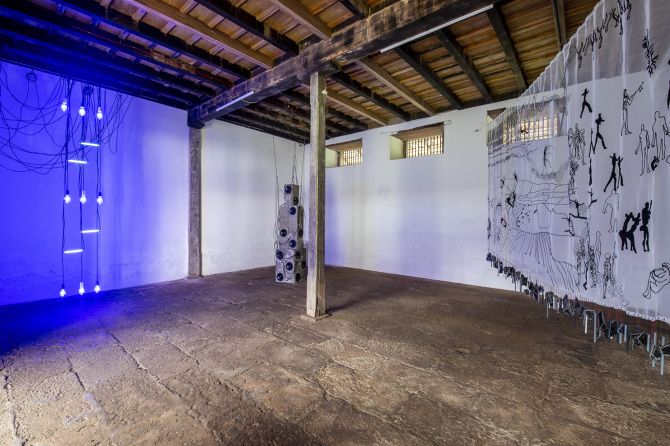
08 May Q’tine Feed: Curated by Suvani Suri (Week 3)
Weekly Round Up: 8th May 2020
Here’s a round up of the stories upto 8th May:
05/05
On the sound of Sound/ Christine Sun Kim
In the absence of ‘hearing with the ear’, what can an investigation into the ‘sound of sound’ reveal…?
Oftentimes, an idea, provocation, question or thought is encountered that turns a given understanding on its head, opening it up to truly radical perspectives.
Christine Sun Kim, is one such artist who has been committed to reconfiguring the understanding of sound, listening and vocalization, releasing the concepts from their conventional meanings. Born deaf, she ventured into thinking through sound and its materiality by exploring it in her texts, drawings, performances, videos, and carefully crafted notational systems.
In her series, “The sound of non-sounds”she employs poetry, musical symbols and graphic notations to create witty and evocative ‘readings’ of non-sounds. She describes the sound of obsession, passing time, temperature rising, relevance and a waiting room, amongst others.
 Through a constantly evolving series of experimental works, Christine continues to challenge our understanding of hearing, pressing people to figure out what sound means to them.
Through a constantly evolving series of experimental works, Christine continues to challenge our understanding of hearing, pressing people to figure out what sound means to them.
In the participatory ‘Game of Skill’, she invites audiences to vocalise a text by her. A handheld device is used to ’scrub’ the tape path, requiring the listener to exert a great deal of effort and attention to be able to produce and listen to an audible and coherent stream as a result.
The film portrait by Todd Selby, reveals more of her work and intriguing processes as it goes behind the scenes with Christine Sun Kim.
–––––
06/05
Listening to Mosquitoes/ Various artists
When it comes to sounds that can drive one up the wall, the buzz of a hovering mosquito is bound to get the unanimous vote for being up there on the list. One of the most familiar yet irksome sounds in our lived experience, it has been turned into a recurring theme and material for artistic inquiry by some!
Vivian Caccuri is one such artist whose recent work ‘Mosquito Shrine’ (at the Kochi Muziris Biennale 2018) zooms in on the micro drones of a mosquito while zooming out and connecting it to the collective subconscious of a colonial past.
Vivian employs recorded and produced samples, mosquito nets, chimes, ultra-violet lights and a massive tower of subwoofers, to create a multi-sensory environment that shakes up established associations of what is considered to be an everyday nuisance, and gives way to a layered and complex discourse about history and social conditioning.
Another work ‘Truce: Strategies for Post-Apocalyptic Computation’ from 2009, by artists Robin Meier and Ali Momoni looks closely at how mosquitoes mate by modulating their flying speeds aka buzzing frequencies! They have created a reciprocal system between a computer and three mosquitos where each tunes their frequencies as per the other’s musical inflections, producing an uncanny synchronization. Interestingly, the stimulus sound produced by the computer to set off the symphony is derived from the North Indian classical vocal tradition of Dhrupad. (On a side note, cannot help but also wonder about the mosquitos that were harmed during the making of the Truce!)
For more on listening to mosquitos, take a look at this playlist of projects and experiments (that we’re continuing to add to)!
–––––
07/05
Design of an earcon/ Brian Eno
In a world saturated with brands, logos and labels, how often do we encounter, recognize and recall signature sounds? The significance of a sonic identity in the design of a product, label, system or service is colossal, yet it is a dimension that is often passed over in the process.
A quick glimpse into the past of sonic branding reveals some iconic delights, many of them associated with the advent of technological systems. Also called earcons, one of the most recognizable of the lot is the Microsoft Windows 95 startup chime, designed and produced by musician Brian Eno– ironically, on a Mac!
Eno, well-known as an ambient composer and producer with acts such as Talking Heads, U2, David Bowie, Coldplay, recounts his experience of designing the 6 second arpeggio that sounded when PCs with Windows 95 were booted up–
“I got completely into this world of tiny, tiny little pieces of music. I was so sensitive to microseconds at the end of this that it really broke a logjam in my own work. Then when I’d finished that and I went back to working with pieces that were like three minutes long, it seemed like oceans of time.”
You can read Eno’s full interview by music critic Joel Selvin here.
––––
One of the key elements of the Performance Programs at GMI are the interdisciplinary studies. The course on Music & Arts Studies led by Suvani Suri is aimed at situating music within a larger framework of artistic intellect, creation and expression. Through weekly seminars and workshops, students are led to understand the historical, cultural, social and philosophical contexts for various kinds of music and art.



No Comments